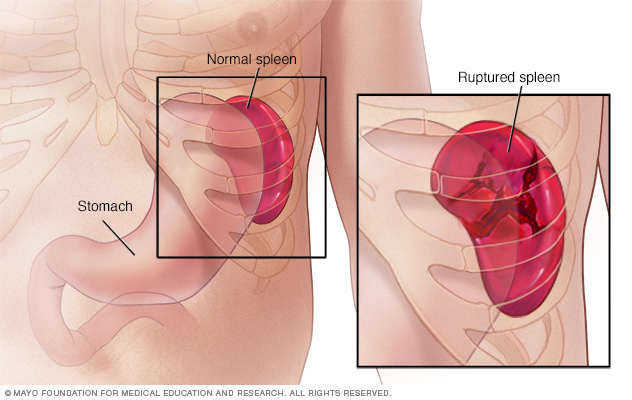Overview
A ruptured spleen is a medical emergency that occurs as a result of a break in your spleen's surface. Your spleen, situated just under your rib cage on your left side, helps your body fight infection and filter old blood cells from your bloodstream.
A forceful blow to your stomach — during a sporting accident, a fistfight or a car crash, for example — is the usual cause of a ruptured spleen. If you have an enlarged spleen, a less forceful trauma might cause rupture. Without emergency treatment, the internal bleeding caused by a ruptured spleen can be life-threatening.
Some people with ruptured spleens need emergency surgery. Others can be treated with several days of hospital care.

Symptoms
Signs and symptoms of a ruptured spleen include:
- Pain in the upper left stomach.
- Tenderness when you touch the upper left stomach.
- Left shoulder pain.
- Confusion, lightheadedness or dizziness.
When to see a doctor
A ruptured spleen is a medical emergency. Seek emergency care after an injury if your signs and symptoms indicate that you may have a ruptured spleen.
Causes
A spleen can rupture due to:
- Injury to the left side of the body. A ruptured spleen is typically caused by a blow to the left upper stomach or the left lower chest, such as might happen during sporting accidents, fistfights and car crashes. An injured spleen can rupture soon after the stomach trauma or, in some cases, days or weeks after the injury.
- An enlarged spleen. Your spleen can become enlarged when blood cells accumulate in the spleen. An enlarged spleen can be caused by various underlying problems, such as mononucleosis and other infections, liver disease, and blood cancers.
Risk factors
If the spleen is already enlarged due to infection or another cause, there is increased risk that the spleen might rupture. Contact sports that involve blows to the chest also increase the risk of a ruptured spleen.
Complications
A ruptured spleen can cause life-threatening bleeding into your stomach cavity.
Prevention
If you've been diagnosed with an enlarged spleen, ask your health care provider whether you need to avoid activities for several weeks that could cause it to rupture. These might include contact sports, heavy lifting and other activities that increase the risk of stomach trauma.
Diagnosis
Tests and procedures used to diagnose a ruptured spleen include:
- Physical exam. Your health care provider will press on your abdomen to determine the size of your spleen and whether it's tender.
- Blood tests. Blood tests will evaluate factors such as platelet count and how well your blood clots.
- Checking for blood in your abdominal cavity. In emergency situations, your health care team might either use an ultrasound or draw a sample of fluid from your stomach with a needle. If the sample reveals blood in your stomach, you might be referred for emergency surgery.
- Imaging tests of your stomach. If your diagnosis isn't clear, your provider might recommend a CT scan of the stomach, possibly with contrast dye, or another imaging test to look for other possible causes of your symptoms.
Treatment
Treatment for a ruptured spleen will depend on the seriousness of your condition. Severe injuries usually require immediate surgery.
Many small or moderate-sized injuries to the spleen can heal without surgery. You're likely to stay in the hospital while your health care team observe your condition and provide nonsurgical care, such as blood transfusions, if necessary.
You might have periodic follow-up CT scans to check whether your spleen has healed or to determine whether you need surgery.
Surgery and other procedures
Surgery for a ruptured spleen can include:
- Repairing the spleen. Your surgeon might be able to use stitches or other techniques to repair the rupture.
- Removing the spleen, called a splenectomy. People can live without a spleen, but it increases the risk of serious bacterial infections such as sepsis. Your health care provider may recommend vaccinations against meningitis, pneumonia and haemophilus influenza, type b (Hib). Occasionally, you may be prescribed daily oral antibiotics to prevent infections.
- Removing part of the spleen. It might be possible to remove only part of your spleen, depending on the rupture. Partial splenectomy reduces the risk of infection that results from removing the entire spleen.
Spleen surgery is generally safe, but any surgery has risks, such as bleeding, blood clots, infection and pneumonia.
© 1998-2025 Mayo Foundation for Medical Education and Research (MFMER). All rights reserved. Terms of Use


